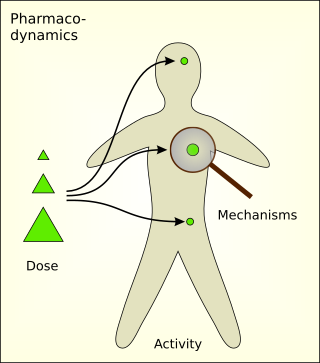Related Research Articles

In vitro studies are performed with microorganisms, cells, or biological molecules outside their normal biological context. Colloquially called "test-tube experiments", these studies in biology and its subdisciplines are traditionally done in labware such as test tubes, flasks, Petri dishes, and microtiter plates. Studies conducted using components of an organism that have been isolated from their usual biological surroundings permit a more detailed or more convenient analysis than can be done with whole organisms; however, results obtained from in vitro experiments may not fully or accurately predict the effects on a whole organism. In contrast to in vitro experiments, in vivo studies are those conducted in living organisms, including humans, known as clinical trials, and whole plants.
Drug tolerance or drug insensitivity is a pharmacological concept describing subjects' reduced reaction to a drug following its repeated use. Increasing its dosage may re-amplify the drug's effects; however, this may accelerate tolerance, further reducing the drug's effects. Drug tolerance is indicative of drug use but is not necessarily associated with drug dependence or addiction. The process of tolerance development is reversible and can involve both physiological factors and psychological factors.

Pharmacodynamics (PD) is the study of the biochemical and physiologic effects of drugs. The effects can include those manifested within animals, microorganisms, or combinations of organisms.
Therapeutic drug monitoring (TDM) is a branch of clinical chemistry and clinical pharmacology that specializes in the measurement of medication levels in blood. Its main focus is on drugs with a narrow therapeutic range, i.e. drugs that can easily be under- or overdosed. TDM aimed at improving patient care by individually adjusting the dose of drugs for which clinical experience or clinical trials have shown it improved outcome in the general or special populations. It can be based on a a priori pharmacogenetic, demographic and clinical information, and/or on the a posteriori measurement of blood concentrations of drugs (pharmacokinetic monitoring) or biological surrogate or end-point markers of effect (pharmacodynamic monitoring).

Haloperidol decanoate, sold under the brand name Haldol Decanoate among others, is a typical antipsychotic which is used in the treatment of schizophrenia. It is administered by injection into muscle at a dose of 100 to 200 mg once every 4 weeks or monthly. The dorsogluteal site is recommended. A 3.75-cm (1.5-inch), 21-gauge needle is generally used, but obese individuals may require a 6.5-cm (2.5-inch) needle to ensure that the drug is indeed injected intramuscularly and not subcutaneously. Haloperidol decanoate is provided in the form of 50 or 100 mg/mL oil solution of sesame oil and benzyl alcohol in ampoules or pre-filled syringes. Its elimination half-life after multiple doses is 21 days. The medication is marketed in many countries throughout the world.

The dose–response relationship, or exposure–response relationship, describes the magnitude of the response of an organism, as a function of exposure to a stimulus or stressor after a certain exposure time. Dose–response relationships can be described by dose–response curves. This is explained further in the following sections. A stimulus response function or stimulus response curve is defined more broadly as the response from any type of stimulus, not limited to chemicals.

Bromperidol, sold under the brand names Bromidol and Impromen among others, is a typical antipsychotic of the butyrophenone group which is used in the treatment of schizophrenia. It was discovered at Janssen Pharmaceutica in 1966. An ester prodrug, bromperidol decanoate, is a long-acting form of bromperidol used as a depot injectable.
NONMEM is a non-linear mixed-effects modeling software package developed by Stuart L. Beal and Lewis B. Sheiner in the late 1970s at University of California, San Francisco, and expanded by Robert Bauer at Icon PLC. Its name is an acronym for NON-linear mixed effects modeling but it is especially powerful in the context of population pharmacokinetics, pharmacometrics, and PK/PD models. NONMEM models are written in NMTRAN, a dedicated model specification language that is translated into FORTRAN, compiled on the fly and executed by a command-line script. Results are presented as text output files including tables. There are multiple interfaces to assist modelers with housekeeping of files, tracking of model development, goodness-of-fit evaluations and graphical output, such as PsN and xpose and Wings for NONMEM. Current version for NONMEM is 7.5.
Pharmacokinetics, sometimes abbreviated as PK, is a branch of pharmacology dedicated to determining the fate of substances administered to a living organism. The substances of interest include any chemical xenobiotic such as: pharmaceutical drugs, pesticides, food additives, cosmetics, etc. It attempts to analyze chemical metabolism and to discover the fate of a chemical from the moment that it is administered up to the point at which it is completely eliminated from the body. Pharmacokinetics is the study of how an organism affects a drug, whereas pharmacodynamics (PD) is the study of how the drug affects the organism. Both together influence dosing, benefit, and adverse effects, as seen in PK/PD models.
Pharmacometrics is a field of study of the methodology and application of models for disease and pharmacological measurement. It uses mathematical models of biology, pharmacology, disease, and physiology to describe and quantify interactions between xenobiotics and patients, including beneficial effects and adverse effects. It is normally applied to quantify drug, disease and trial information to aid efficient drug development, regulatory decisions and rational drug treatment in patients.
Safety pharmacology is a branch of pharmacology specialising in detecting and investigating potential undesirable pharmacodynamic effects of new chemical entities (NCEs) on physiological functions in relation to exposure in the therapeutic range and above.
In the field of pharmacokinetics, the area under the curve (AUC) is the definite integral of the concentration of a drug in blood plasma as a function of time. In practice, the drug concentration is measured at certain discrete points in time and the trapezoidal rule is used to estimate AUC. In pharmacology, the area under the plot of plasma concentration of a drug versus time after dosage gives insight into the extent of exposure to a drug and its clearance rate from the body.

Repinotan (BAYx3702), an aminomethylchroman derivative, is a selective 5-HT1A receptor full agonist with high potency and efficacy. It has neuroprotective effects in animal studies, and was trialed in humans for reducing brain injury following head trauma. It was subsequently trialed up to phase II for treatment of stroke, but while side effects were mild and consisted mainly of nausea, repinotan failed to demonstrate sufficient efficacy to justify further clinical trials. However, repinotan continues to be investigated for other applications, and was found to be effective at counteracting the respiratory depression produced by morphine, though with slight reduction in analgesic effects.
In vitro to in vivo extrapolation (IVIVE) refers to the qualitative or quantitative transposition of experimental results or observations made in vitro to predict phenomena in vivo, biological organisms.
Quantitative systems pharmacology (QSP) is a discipline within biomedical research that uses mathematical computer models to characterize biological systems, disease processes and drug pharmacology. QSP can be viewed as a sub-discipline of pharmacometrics that focuses on modeling the mechanisms of drug pharmacokinetics (PK), pharmacodynamics (PD), and disease processes using a systems pharmacology point of view. QSP models are typically defined by systems of ordinary differential equations (ODE) that depict the dynamical properties of the interaction between the drug and the biological system.

Vamorolone is a synthetic steroid, which is under development for the treatment of Duchenne muscular dystrophy.
Leon Aarons is an Australian chemist who researches and teaches in the areas of pharmacodynamics and pharmacokinetics. He lives in the United Kingdom and from 1976 has been a professor of pharmacometrics at the University of Manchester. In the interest of promoting the effective development of drugs, the main focus of his work is optimizing pharmacological models, the design of clinical studies, and data analysis and interpretation in the field of population pharmacokinetics. From 1985 to 2010 Aarons was an editor emeritus of the Journal of Pharmacokinetics and Pharmacodynamics and is a former executive editor of the British Journal of Clinical Pharmacology.

Malcolm Rowland FBPhS is Emeritus Professor of Pharmacy, University of Manchester, and Adjunct Professor, University of California San Francisco. His research in pharmacology, has been particularly in physiologically based pharmacokinetics. He has written several textbooks on the subject.

SAAM II, short for "Simulation Analysis and Modeling" version 2.0, is a renowned computer program designed for scientific research in the field of bioscience. It is a descriptive and exploratory tool in drug development, tracers, metabolic disorders, and pharmacokinetics/pharmacodynamics research. It is grounded in the principles of multi-compartment model theory, which is a widely-used approach for modeling complex biological systems. SAAM II facilitates the construction and simulation of models, providing researchers with a friendly user interface allowing the quick run and multi-fitting of simple and complex structures and data. SAAM II is used by many Pharma and Pharmacy Schools as a drug development, research, and educational tool.
Target-mediated drug disposition (TMDD), is the process in which a drug binds with high affinity to its pharmacological target to such an extent that this affects its pharmacokinetic characteristics. Various drug classes can exhibit TMDD, most often these are large compounds but also smaller compounds can exhibit TMDD . A typical TMDD pattern of antibodies displays non-linear clearance and can be seen at concentration ranges that are usually defined as 'mid-to-low'. In this concentration range, the target is partly saturated.
References
- ↑ Hahn, J. O.; Khosravi, S.; Dumont, G. A.; Ansermino, J. M. (2011). "Two-stage vs mixed-effect approach to pharmacodynamic modeling of propofol in children using state entropy". Pediatric Anesthesia. 21 (6): 691–698. doi:10.1111/j.1460-9592.2011.03584.x. PMID 21518104. S2CID 23414752.
- ↑ Goutelle, S.; Maurin, M.; Rougier, F.; Barbaut, X.; Bourguignon, L.; Ducher, M.; Maire, P. (2008). "The Hill equation: A review of its capabilities in pharmacological modelling". Fundamental & Clinical Pharmacology. 22 (6): 633–48. doi:10.1111/j.1472-8206.2008.00633.x. PMID 19049668. S2CID 4979109.
- ↑ Derendorf, H.; Meibohm, B. (1999). "Modeling of pharmacokinetic/pharmacodynamic (PK/PD) relationships: Concepts and perspectives". Pharmaceutical Research. 16 (2): 176–185. doi:10.1023/A:1011907920641. PMID 10100300. S2CID 23165736.
- ↑ Upton, Rn; Mould, Dr (2014). "Basic Concepts in Population Modeling, Simulation, and Model-Based Drug Development: Part 3-Introduction to Pharmacodynamic Modeling Methods". CPT: Pharmacometrics & Systems Pharmacology. 3 (1): 88. doi:10.1038/psp.2013.71. PMC 3917320 . PMID 24384783.
- ↑ Meibohm, B.; Derendorf, H. (October 1997). "Basic concepts of pharmacokinetic/pharmacodynamic (PK/PD) modelling". International Journal of Clinical Pharmacology and Therapeutics. 35 (10): 401–413. ISSN 0946-1965. PMID 9352388.
- ↑ Pharmaceutical Biotechnology: Fundamentals and Applications. Crommelin, Daan; Meibohm, Bernd; Sindelar, Robert. Third Edition. Informa Healthcare USA. 2008.
- ↑ Mager, Donald E.; Wyska, Elzbieta; Jusko, William J. (2003-05-01). "Diversity of Mechanism-Based Pharmacodynamic Models". Drug Metabolism and Disposition. 31 (5): 510–518. doi:10.1124/dmd.31.5.510. ISSN 0090-9556. PMID 12695336.
- ↑ Dayneka, Natalie L.; Garg, Varun; Jusko, William J. (August 1993). "Comparison of Four Basic Models of Indirect Pharmacodynamic Responses". Journal of Pharmacokinetics and Biopharmaceutics. 21 (4): 457–478. doi:10.1007/BF01061691. ISSN 0090-466X. PMC 4207304 . PMID 8133465.
- ↑ Aarons, L.; Karlsson, M. O.; Mentré, F.; Rombout, F.; Steimer, J. L.; van Peer, A.; COST B15 Experts (May 2001). "Role of modelling and simulation in Phase I drug development". European Journal of Pharmaceutical Sciences. 13 (2): 115–122. doi:10.1016/S0928-0987(01)00096-3. ISSN 0928-0987. PMID 11297895.
- ↑ Rajman, Iris (2008-04-01). "PK/PD modelling and simulations: utility in drug development". Drug Discovery Today. 13 (7): 341–346. doi:10.1016/j.drudis.2008.01.003. PMID 18405847.
- ↑ Karlsson, Mats O.; Anehall, Therese; Friberg, Lena E.; Henningsson, Anja; Kloft, Charlotte; Sandström, Marie; Xie, Rujia (2005-03-01). "Pharmacokinetic/Pharmacodynamic Modelling in Oncological Drug Development". Basic & Clinical Pharmacology & Toxicology. 96 (3): 206–211. doi: 10.1111/j.1742-7843.2005.pto960310.x . ISSN 1742-7843. PMID 15733216.
- ↑ Food and Drug Administration (2018-08-24). "Exposure-Response Relationships — Study Design, Data Analysis, and Regulatory Applications". U.S. Food and Drug Administration. Retrieved 2022-05-09.